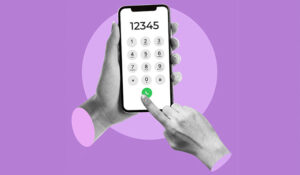Five9’s Angela Williams looks at whether you should DIY your number reputation management.
Are you struggling to keep improper spam or scam labels off your phone numbers or calling campaigns on behalf of your clients? Are you unsure how to fix it?
If so, we’d wager that dealing with having your calls mislabeled is probably something you’re not used to dealing with or solving.
Unless you can staff a team within the IT or outbound dialing part of your business dedicated to staying on top of your spam labeling issues, knowing how to maintain a healthy number reputation can be challenging.
Searching for the various options for solutions on the market may lead you to find confusing amounts of misinformation that will leave you wondering: why can’t I just fix my spam labels on my own?
There are many kinds of monitoring solutions with limited insight into your spam tagging issues, and you could spend the time analyzing and strategizing how to rotate phone numbers to avoid the tags. Still, the reality is that you’re probably not as well-equipped to handle your spam labels as you may think.
Spoiler alert – Five9 can now provide Number Reputation Management to you if you’re ready to cross ‘managing this on my own’ off your to-do list and work with us to solve the problem. But, in the event you’re evaluating a DIY approach, here’s what we’d recommend you consider.
The Setup to Monitor the Reputation of Your Phone Numbers
If you can track the problem, you have the data to do something about it. The problem is this tracking is no easy feat, and you need to evaluate if you can effectively measure why spam labels appear on your numbers and how they impact your business KPIs.
You won’t get very far if you don’t feel confident in your current tools, methods, or platforms to manage your spam labeling issues.
Here’s the setup and what it would take to monitor a single phone number/spam label on your own:
- You’ll need the basic infrastructure – whether you already have one with the right capabilities, you build one, or invest in one – where you can view and manage all your outbound phone numbers and calling campaigns across all the major wireless networks. Ideally, this would be a single source/platform for the necessary data-gathering to track which calls in which campaigns are being mislabeled as spam to provide needed insight into how to proceed from there and dispute the labels down the line.
- This source or platform must be able to track calls and campaigns and report any improper spam/scam/fraud labeling or mislabeling on your numbers across all the carriers.
- Reporting alone won’t cut it. You’ll need a way to be notified if and when spam labeling occurs, not when your customers (who surprisingly picked up the call) let you know it’s happening or after your contact rates and other calling KPIs take a nosedive. You’ll need the spam labeling data to be accessible and as up-to-date as possible across all the carriers when you check your numbers for labeling issues.
- Phone number and outbound calling campaign management are already a significant investment, both financially and in your time and resources. Dealing with your spam labeling issues on top of that can further exhaust your current resources. You’ll have to ensure you have enough people with the right tools to keep track of your numbers and campaigns. At the same time, you’ll add new responsibilities to monitor for any improper scam tags and the processes and time for mitigating those labels should they arise. If that’s the case, are your current structure and methods scalable for you and your team to manage effectively?
What It Takes to Fix 1 Spam Label on Your Own
Once you feel confident in your systems architecture for monitoring, detecting, and reporting your spam labels, it’s time to figure out how you’re going to fix the spam or scam labels harming your calls; this is an entirely separate process that requires relationships to all the major wireless carriers.
Here’s what it would take to mitigate and correct just one spam label on one phone number (keep in mind that removing more intense warning labels, like fraud, is typically denied):
- Each wireless carrier has its own support process where you need to submit your labeling appeals. It’s not enough to correct a label on one carrier; a number may ring through as “Potential Spam” via one carrier, be clean on another, and display “Scam Likely” on another because they all have their own analytics engines scoring and labeling your calls. You’ll need insight, relationships, or direct access to each carrier independently.
- From there, you’ll need to consider the following factors when submitting a support ticket to the carriers to fix the label (please note that the following data is based on carrier averages across a single phone number)
- It may take up to 30 minutes to submit the necessary information in a support ticket to a carrier — or 90 minutes if a number is mislabeled across all three. Plus, it may take several communications back and forth to get everything needed to consider the remediation appeal.
- Each carrier is different in what they require, but the data typically needed for support tickets includes the phone number, the root entity caller and/or the brand entity caller, what rating or label your call was scored with (with proof), and your contact information.
- It may take up to five business days to receive any kind of response from the carrier, whether positive or negative, about your appeals tickets. If denied, more actions are required from there, and you may need to rest, rotate, or replace that phone number (and hope it already doesn’t have a spam label associated with it too).
- Once you submit any support to any of the carriers, there is a 0% guarantee that the spam label will be corrected. Can you afford to wait this long just to get denied? Do you have a backup plan?
- With 25% of a business’ phone calls typically at risk for spam labeling events, you’ll likely have more than one label to mitigate at one time. If you’re a heavy dialer, we’d recommend doing the math on how much 25% represents for you. Are you ready to handle that many support tickets in an ongoing fashion?
It Doesn’t End Here
Independent number reputation strategies require more than daily monitoring and support ticket submissions. Here are a few more items to consider that you’ll need to make sure you’re staying on top of:
- Can you trust your data? If you only have monitoring capabilities (no remediation process built in for you), you may doubt how updated the data you’re getting is. Real-time monitoring is a costly solution, so most rely on outdated or batched data to report your labels, so many opt-in to buying multiple test phones. Each one needs a different plan across the various carriers so you can place test calls to them and ensure that the labels reporting to you are accurate.
- How many mobile devices would you need to invest in depending on the volume of numbers you have or calls you make? Or what mechanisms do you have in place that provide the certainty you need to trust the data?
- If you choose to swap or frequently rotate your numbers to avoid spam labels, you need to ensure you’re doing so in a respectful and compliant manner because the algorithms are on the lookout for that type of avoidant and sometimes suspicious behavior.
- If you’re dialing at high volumes and rotating frequently, you need adequate resources to hand that rotation to succeed and be ahead of the labeling, which has proven quite tricky.
- Can you accept that “new” phone numbers are likely not “new,” just new to you, and may come with baggage inherited from their previous users? Some percentage of numbers you add into your rotation is likely already at risk before you even start dialing.
- Does your team feel well-equipped to track all numbers, campaigns, and spam/scam tagging to make the appropriate number swaps, support ticket submissions, and dialing strategies in an insightful and actionable manner?
- Do you or your team know how to stay updated with the latest compliance expectations for your dialing practices, which are constantly evolving? Do you know which new practices could lead you to be negatively labeled as spam?
- Decisions are happening at the regulatory level every day that impact your calls. With the standards and technologies constantly evolving with the carriers and the delivery of call traffic, you must have someone on your team who can stay on top of the latest regulatory matters affecting your business.
This blog post has been re-published by kind permission of Five9 – View the Original Article
For more information about Five9 - visit the Five9 Website
Call Centre Helper is not responsible for the content of these guest blog posts. The opinions expressed in this article are those of the author, and do not necessarily reflect those of Call Centre Helper.
Author: Five9
Published On: 27th Jul 2023 - Last modified: 9th Dec 2024
Read more about - Guest Blogs, Five9






 Five9 empowers organizations to create hyper-personalized and effortless AI-driven customer experiences that deliver better business outcomes. Powered by Five9 Genius AI and our people, the Five9 Intelligent CX Platform is trusted by 3,000+ customers and 1,400+ partners globally. The New CX starts here and it's at the heart of every winning experience.
Five9 empowers organizations to create hyper-personalized and effortless AI-driven customer experiences that deliver better business outcomes. Powered by Five9 Genius AI and our people, the Five9 Intelligent CX Platform is trusted by 3,000+ customers and 1,400+ partners globally. The New CX starts here and it's at the heart of every winning experience. 









